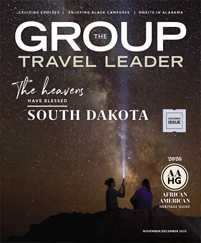There’s no place like South Texas.
Rich in history, culture and natural beauty, the region beckons visitors with abundant sunshine and mild temperatures from autumn through spring — although summer can be as hot as the local chiles. Before the arrival of the Spanish, these arid lands were home to Indigenous peoples, followed by Franciscan missionaries from Spain, Mexican rancheros and Southern separatists. Today, it offers a mix of experiences, from historic landmarks to coastal beaches.
In San Antonio, visitors can walk along the famous River Walk and explore the historic site of the Alamo. Beyond that, the city’s Spanish colonial past is preserved in its five missions, collectively designated as a UNESCO World Heritage site. Visitors can explore these historic sites and unique neighborhoods, from the art galleries of Southtown to the lively market square of El Mercado.
In Corpus Christi, the “Sparkling City by the Sea,” the focus is on the coast, and the city’s identity is deeply tied to the Gulf of Mexico. With miles of sandy beaches, a world-class aquarium and museums that highlight its maritime heritage, it’s a destination for recreation and reflection. Visitors can tour the historic aircraft carrier USS Lexington, now a floating museum; enjoy the natural beauty of nearby Padre Island National Seashore; or simply contemplate spectacular sunsets from one of the many bars and restaurants lining the bay.
A border city where the United States and Mexico meet, Laredo reveals a blend of cultures that’s central to its identity, all visible in the food, marketplaces and the historic downtown that overlooks the Rio Grande. As home to Port Laredo, the largest inland port on the southern border, Laredo is a city of both commerce and connection. From taquerias to traditional art and music, Laredo celebrates its binational heritage.
San Antonio
One of the most enchanting cities in the country, San Antonio never fails to charm. Of course, there’s the omnipresent Alamo (where a new visitor center and museum will open next year), but the “Cradle of Texas Liberty” also boasts burgeoning arts districts and an unparalleled culinary scene. The city was honored in 2017 as a UNESCO Creative City of Gastronomy, becoming only the second city in the United States to receive this designation.
“The first-stop, must-see is, of course, the Alamo and the River Walk — the top two attractions in the state of Texas,” said Dave Krupinski, leisure development officer for Visit San Antonio. “However, we encourage groups to get off the beaten path and explore neighborhood gems and more cultural finds, such as the Broadway Corridor — chock full of museums, the San Antonio Zoo and the San Antonio Botanical Garden.”
Another must-see is San Fernando Cathedral. Located in the heart of the Alamo City, the cathedral was founded in 1731 and is the oldest continuously functioning religious community in the state. In the evening, don’t forget to catch The Saga, a jaw-dropping light show projected onto the cathedral’s façade. The free show takes viewers on a visual journey through the city’s past, present and future.
Those in search of a modern, urban vibe in a historic setting should set out for The Pearl. Covering more than 20 acres, the former brewery complex now boasts stunning luxury lodgings at Hotel Emma and more than two dozen restaurants, along with nightlife, shopping, and lively farmers and makers markets.
Four historic missions make up the San Antonio Missions National Historical Park, which, along with the Alamo, comprise the only UNESCO World Heritage Site in the Lone Star State. A hiking and biking trail connects the missions to downtown San Antonio, and daily ranger-led presentations provide more insight into these important outposts. The park’s brand-new World Heritage Center is a gateway to the missions and a great place to get oriented.
Corpus Christi
The largest beach destination in the state, Corpus Christi is blessed with seven islands and nine beaches, and the city has long been a favored vacation spot for Texans. The crown jewel of these is undoubtedly Padre Island National Seashore. The longest undeveloped barrier island in the world, Padre has 65 miles of pristine Gulf beach, including dunes, tidal flats and Laguna Madre, a shallow, extremely salinized estuary that’s one of the best windsurfing spots in the United States.
Birds favor Corpus Christi as well; it’s been designated the “Birdiest City in America” for 10 years in a row. Hundreds of species converge to nest, migrate and wade in the country’s biggest flyway, drawing avian enthusiasts from around the globe.
“We have almost 300 days of sunshine a year,” said America Segura, director of communications at Visit Corpus Christi. “Our weather is completely sunny almost year-round. So, people are able to enjoy the beach in November, sometimes even in December.”
The different beaches offer a variety of experiences. “People love to come and drive on our beaches,” she said. “But we also have National Seashore, where cars are prohibited, and North Beach and McGee Beach, city beaches located near the downtown area that are not drivable. And, while most beach destinations focus solely on the outdoor and recreational activities, we have an abundance of things to do indoors, as well.”
Among those indoor activities is the Texas State Aquarium. One of the largest and best in the nation, the aquarium focuses on the species of the Gulf of Mexico and the Caribbean Sea, including dolphins, turtles, stingrays and sharks.
Another only-in-Corpus Christi attraction is anchored in the harbor. Built for the Navy during World War II, the USS Lexington is an Essex-class carrier that was featured in the 2001 film “Pearl Harbor.” Now a museum, the Lexington’s flight deck offers a close-up look at 20 aircraft, including the F-14 Tomcat jet flown in the movie “Top Gun.” Other attractions include escape rooms, a flight simulator and a 3D theater.
Corpus Christi’s cuisine features an abundance of fresh seafood, including oysters and shrimp. Groups that are interested can opt for a “cook your catch” experience, where they charter a boat and bring their catch back to participating restaurants that will grill, fry, blacken or prepare it in any manner that suits their tastes.
Art lovers will want to check out the Art Center of Corpus Christi, along with the Art Museum of South Texas, the Texas State Museum of Asian Cultures & Education Center, and many smaller galleries that are scattered throughout the city. The queen of Tejano music, the late Selena Quintanilla-Pérez, also called Corpus Christi home. A bronze statue located on the Corpus Christi Bayfront Seawall honors her legacy, and her family operates a small museum dedicated to her life and music.
Laredo
Founded in 1755, the city on the north bank of the Rio Grande — just across from Mexico’s Nuevo Laredo — Laredo served briefly as the capital of the storied but short-lived Republic of the Rio Grande, which declared its independence from Mexico in 1840. (Visit the Republic of the Rio Grande Museum for the full story of the independent nation.) Today, the vibrant border town beckons visitors who enjoy soaking up the atmosphere of a truly authentic destination.
“I guess in most of Texas, or at least part of Texas, it’s Tex-Mex — but here, we’re Mex-Tex,” said Joel Vazquez, assistant director for the Laredo Convention and Visitors Bureau. “For people who may not want to cross the border right now, Laredo brings authentic Mexico to them.”
Filled with colorful murals and compelling history, Laredo offers beautifully preserved 19th-century architecture and colonial charm. The oldest part of the city is anchored by the San Agustin Cathedral. Presiding proudly over the plaza that bears the same name, the current stone structure replaced the original adobe chapel in 1810.
Modern marvels are on display at the Lamar Bruni Vergara Planetarium on the campus of Texas A&M International University. The 40-foot planetarium is encased in a glass pyramid and features a state-of-the-art digital projection system that makes visitors feel as if they’re truly in the heavens.
Laredo has more than 40 sister cities in Mexico and Latin America. Each summer, over 200 vendors and artisans from those communities gather to celebrate the Sister Cities Festival, a free three-day extravaganza of handmade crafts, traditional clothing, jewelry and regional goods that fills the Sames Auto Arena with joyful music and the smell of griddled tortillas and simmering chiles.
“This is a great market for people who, basically, they want to experience Mexico,” Vazquez said. “This year, we had our first 5k run with the festival, which was very successful. And we partnered with the state of Queretaro, and we did a Lele workshop, where people could build their own Lele.” (Leles are Mexican rag dolls that are significant in the Indigenous Otomi community.)









